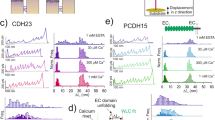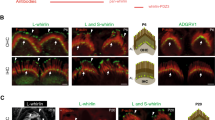Abstract
Mechanoelectrical transduction, the conversion of mechanical force into electrochemical signals, underlies a range of sensory phenomena, including touch, hearing and balance. Hair cells of the vertebrate inner ear are specialized mechanosensors that transduce mechanical forces arising from sound waves and head movement to provide our senses of hearing and balance1,2; however, the mechanotransduction channel of hair cells and the molecules that regulate channel activity have remained elusive. One molecule that might participate in mechanoelectrical transduction is cadherin 23 (CDH23), as mutations in its gene cause deafness and age-related hearing loss3,4,5,6. Furthermore, CDH23 is large enough to be the tip link, the extracellular filament proposed to gate the mechanotransduction channel7. Here we show that antibodies against CDH23 label the tip link, and that CDH23 has biochemical properties similar to those of the tip link. Moreover, CDH23 forms a complex with myosin-1c, the only known component of the mechanotransduction apparatus8, suggesting that CDH23 and myosin-1c cooperate to regulate the activity of mechanically gated ion channels in hair cells.
This is a preview of subscription content, access via your institution
Access options
Subscribe to this journal
Receive 51 print issues and online access
$199.00 per year
only $3.90 per issue
Buy this article
- Purchase on Springer Link
- Instant access to full article PDF
Prices may be subject to local taxes which are calculated during checkout




Similar content being viewed by others
References
Müller, U. & Evans, A. L. Mechanisms that regulate mechanosensory hair cell differentiation. Trends Cell Biol. 11, 334–342 (2001)
Gillespie, P. G. & Walker, R. G. Molecular basis of mechanosensory transduction. Nature 413, 194–202 (2001)
Di Palma, F. et al. Mutations in Cdh23, encoding a new type of cadherin, cause stereocilia disorganization in waltzer, the mouse model for Usher syndrome type 1D. Nature Genet. 27, 103–107 (2001)
Bolz, H. et al. Mutation of CDH23, encoding a new member of the cadherin gene family, causes Usher syndrome type 1D. Nature Genet. 27, 108–112 (2001)
Bork, J. M. et al. Usher syndrome 1D and nonsyndromic autosomal recessive deafness DFNB12 are caused by allelic mutations of the novel cadherin-like gene CDH23. Am. J. Hum. Genet. 68, 26–37 (2001)
Noben-Trauth, K., Zheng, Q. Y. & Johnson, K. R. Association of cadherin 23 with polygenic inheritance and genetic modification of sensorineural hearing loss. Nature Genet. 35, 21–23 (2003)
Pickles, J. O., Comis, S. D. & Osborne, M. P. Cross-links between stereocilia in the guinea pig organ of Corti, and their possible relation to sensory transduction. Hear. Res. 15, 103–112 (1984)
Holt, J. R. et al. A chemical-genetic strategy implicates myosin-1c in adaptation by hair cells. Cell 108, 371–381 (2002)
Corey, D. P. & Hudspeth, A. J. Kinetics of the receptor current in bullfrog saccular hair cells. J. Neurosci. 3, 962–976 (1983)
Assad, J. A., Shepherd, G. M. & Corey, D. P. Tip-link integrity and mechanical transduction in vertebrate hair cells. Neuron 7, 985–994 (1991)
Goodyear, R. J. & Richardson, G. P. A novel antigen sensitive to calcium chelation that is associated with the tip links and kinocilial links of sensory hair bundles. J. Neurosci. 23, 4878–4887 (2003)
Takeichi, M. Cadherins: a molecular family important in selective cell–cell adhesion. Annu. Rev. Biochem. 59, 237–252 (1990)
Boggon, T. J. et al. C-cadherin ectodomain structure and implications for cell adhesion mechanisms. Science 296, 1308–1313 (2002)
Siemens, J. et al. The Usher syndrome proteins cadherin 23 and harmonin form a complex by means of PDZ-domain interactions. Proc. Natl Acad. Sci. USA 99, 14946–14951 (2002)
Little, K. F. & Neugebauer, C. D. Interconnections between the stereovilli of the fish inner ear. II. Systematic investigation of saccular bundles from Rutilus rutilus (Teleostei). Cell Tissue Res. 242, 427–432 (1985)
Pickles, J. O., Rouse, G. W. & von Perger, M. Morphological correlates of mechanotransduction in acousticolateral hair cells. Scan. Microsc. 5, 1115–1128 (1991)
Furness, D. N., Karkanevatos, A., West, B. & Hackney, C. M. An immunogold investigation of the distribution of calmodulin in the apex of cochlear hair cells. Hear. Res. 173, 10–20 (2002)
Kachar, B., Parakkal, M., Kurc, M., Zhao, Y. & Gillespie, P. G. High-resolution structure of hair-cell tip links. Proc. Natl Acad. Sci. USA 97, 13336–13341 (2000)
Hasson, T. et al. Unconventional myosins in inner-ear sensory epithelia. J. Cell Biol. 137, 1287–1307 (1997)
Zhao, Y., Yamoah, E. N. & Gillespie, P. G. Regeneration of broken tip links and restoration of mechanical transduction in hair cells. Proc. Natl Acad. Sci. USA 93, 15469–15474 (1996)
Osborne, M. P. & Comis, S. D. Action of elastase, collagenase and other enzymes upon linkages between stereocilia in the guinea-pig cochlea. Acta Otolaryngol. (Stockh.) 110, 37–45 (1990)
Goodyear, R. & Richardson, G. The ankle-link antigen: an epitope sensitive to calcium chelation associated with the hair-cell surface and the calycal processes of photoreceptors. J. Neurosci. 19, 3761–3772 (1999)
Gillespie, P. G., Wagner, M. C. & Hudspeth, A. J. Identification of a 120 kd hair-bundle myosin located near stereociliary tips. Neuron 11, 581–594 (1993)
Söllner, C. et al. Mutations in cadherin 23 affect tip links in zebrafish sensory hair cells. Nature advance online publication 31 March 2004 (doi:10.1038/nature02484)
Boeda, B. et al. Myosin VIIa, harmonin and cadherin 23, three Usher I gene products that cooperate to shape the sensory hair cell bundle. EMBO J. 21, 6689–6699 (2002)
Hudspeth, A. J. & Gillespie, P. G. Pulling springs to tune transduction: adaptation by hair cells. Neuron 12, 1–9 (1994)
Garcia, J. A., Yee, A. G., Gillespie, P. G. & Corey, D. P. Localization of myosin-Iβ near both ends of tip links in frog saccular hair cells. J. Neurosci. 18, 8637–8647 (1998)
Shepherd, G. M. G., Assad, J. A., Prarakkal, M., Kachar, B. & Corey, D. P. Movement of the tip-link attachment is correlated with adaptation in bullfrog saccular hair cells. J. Gen. Physiol. 98, 25A (1991)
Nagafuchi, A. & Takeichi, M. Cell binding function of E-cadherin is regulated by the cytoplasmic domain. EMBO J. 7, 3679–3684 (1988)
Acknowledgements
We thank R. Kemler for E-cadherin clones; M. Senften for L929 cells expressing E-cadherin; T. Hasson, B. Ranscht and H. C. VanSteenhouse for technical advice; and A. Kralli, L. Stowers and A. Patapoutian for critical reading of the manuscript. J.S. was supported by a fellowship from the Boehringer Ingelheim Fonds; A.R. by a C. J. Martin Fellowship from the National Health and Medical Research Council (Australia). This work was supported by grants from the NIDCD and NEI (U.M, P.G.G. and D.S.W.).
Author information
Authors and Affiliations
Corresponding author
Ethics declarations
Competing interests
The authors declare that they have no competing financial interests.
Supplementary information
Supplementary Figure 1
Characterization of CDH23 antibodies. (JPG 41 kb)
Supplementary Figure 2
Characterization of CDH23 antibodies. (JPG 23 kb)
Supplementary Figure 3
Electron micrograph of the kinocilium and adjacent stereocilia of a bullfrog hair cell. (JPG 144 kb)
Supplementary Figure 4
CDH23 expressing cell lines. (JPG 31 kb)
Supplementary Figure 5
Colocalization of IL2R-CDH23 with MYO1C in COS cells. (JPG 47 kb)
Rights and permissions
About this article
Cite this article
Siemens, J., Lillo, C., Dumont, R. et al. Cadherin 23 is a component of the tip link in hair-cell stereocilia. Nature 428, 950–955 (2004). https://doi.org/10.1038/nature02483
Received:
Accepted:
Published:
Issue Date:
DOI: https://doi.org/10.1038/nature02483
This article is cited by
-
The Piezo channel is a mechano-sensitive complex component in the mammalian inner ear hair cell
Nature Communications (2024)
-
Comparative transcriptome profiling reveals RNA splicing alterations and biological function in patients exposed to occupational noise
Environmental Science and Pollution Research (2023)
-
Hippo-Yap/Taz signalling in zebrafish regeneration
npj Regenerative Medicine (2022)
-
Genetic etiology of hereditary hearing loss in the Gulf Cooperation Council countries
Human Genetics (2022)
-
Inner hair cell stereocilia are embedded in the tectorial membrane
Nature Communications (2021)
Comments
By submitting a comment you agree to abide by our Terms and Community Guidelines. If you find something abusive or that does not comply with our terms or guidelines please flag it as inappropriate.



